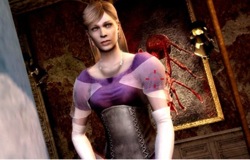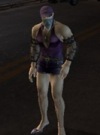This is the second half of our feature on transgender video game characters. Read the first half HERE.
The turn of the millennium saw a bit of a step backwards for TG characters in games. For decades, the transgender community has been plagued by the Norman Bates “Psycho” stereotype which depicts transvestites as unhinged and dangerous. The new millennium started off with two games that used such a depiction of transgender people. 2001 Alexia Ashford Resident Evil: Code Veronica (Capcom)
2001 Alexia Ashford Resident Evil: Code Veronica (Capcom)
The Dreamcast’s Resident Evil: Code Veronica pit the heroes against a pair of evil twins named Alfred and Alexia Ashford. Around halfway through the game, players discover that Alfred and Alexia are actually the same person. The real Alexia Ashford was cryogenically frozen in a lab, and her deranged brother developed a split personality, and began dressing as his sister. Despite being an insane murderous sissy, at least Alfred/Alexia got a significant role in the first half of the game.
 2002 Psycho Killer Grand Theft Auto Vice City (Rockstar Games)
2002 Psycho Killer Grand Theft Auto Vice City (Rockstar Games)
It didn’t help much when Grand Theft Auto Vice City had a mission in which Tommy Vercetti is hired to protect the fictional band Love Fist from an obsessed fan. In the unfortunately titled mission “Psycho Killer”, the Norman Bates stereotype appears again, as the fan turns out to be a killer transvestite. Grand Theft Auto is the last place to look for political correctness; you brutally murder every conceivable sort of negative stereotype in that franchise, so perhaps a mission where players gun down a transvestite means that Rockstar Games views the transgender as being equal to everyone else.
 2003 Bridget Guilty Gear XX (Sammy Studios)
2003 Bridget Guilty Gear XX (Sammy Studios)
Things started to look better in 2003 when Guilty Gear series added a young lady named Bridget to the cast. Bridget was actually a boy dressed as a girl. Text from the game stated that fact quite clearly; Bridget had a twin brother and his village considered twin boys to be a bad omen. Therefore Bridget was raised as a girl. What makes this a great example of a transgender character is that Guilty Gear is a fighting game, so players can control Bridget through the entire storyline. The crossdressing isn’t reserved to just one sequence, but is present throughout the game.
Bridget is also smokin’ hot.

2003 Rikimaru, Ayame Tenchu Wrath of Heaven (Activision)
This installment of the Tenchu series had a bit of accidental crossdressing. The game allows players to control a male or female ninja. Both of whom have a special ability to disguise themselves as a randomly selected villager. Sometimes this will result in a male ninja disguising himself as a woman. It can also turn the female ninja into a man.
 2005 Various Beatdown: Fists of Vengeance (Capcom)
2005 Various Beatdown: Fists of Vengeance (Capcom)
One of the least noteworthy games of 2005 was Beatdown: Fists of Vengeance. A by-the-numbers beat ‘em up, its only distinctive feature was the option to dress up any of your characters in any clothing piece you had acquired. This meant that you could cross dress. This sort of unofficial transvestism made it’s way into numerous other games which featured both male and female characters, but its gimmicky nature doesn’t offer anything in the way of a positive role model.
 2006 Frank West Dead Rising (Capcom)
2006 Frank West Dead Rising (Capcom)
In 2006, zombies invaded a mall in the game Dead Rising, and players took control of photojournalist Frank West as he covered the undead outbreak. Frank was a manly man who could grab anything he found in the mall and use it as a weapon. He could also dress up in any piece of clothing he found lying around the mall… and developers made sure that there were plenty of women’s clothing stores around. Frank isn’t written as a transvestite, but he’s the only playable character in the game, so the designers put the dresses in the game just so that players could turn Frank into their own personal Barbie doll.
 2008 Various Persona 4 (Atlus)
2008 Various Persona 4 (Atlus)
Most of the characters in Persona 4 from 2008 count as crossdressers due to a sequence in which all of the male characters compete in a drag beauty pageant. However, one character in particular seems to take to the role quite enthusiastically; Teddie. He spends much of the game depicted as an effeminate boy, but for the pageant, he shows up dressed like Alice from Alice in Wonderland (Also a nod to an Alice-inspired character from the other Persona games). Teddie’s convincing girliness, and willingness to embrace of his feminine side make him an excellent positive portrayal of a crossdresser.

2010 Kaine Nier (Square Enix)
Last year gave us the best transgender character of all time, Kaine from the obscure action RPG Nier. Kaine is a perfect role model for transgender gamers; she’s gorgeous, tough, and heroic. She even saves the day several times over the course of the game. She isn’t a playable character, but she’s a central figure in the story, and there’s an unlockable replay mode which adds in additional text and dialog to explain her backstory more deeply. Several of the game’s multiple endings of the game focus on Kaine.
Kaine’s transgender state is never directly stated in the game, although it is implied in many ways. She’s an outcast with a tragic past, and a love for skimpy costumes. She looks like a lingerie model, fights like a Spartan, and if players work hard enough to unlock the best ending, Kaine gets a happy ending. What’s great about how Nier handles the issue is that being a transgendered person isn’t a gimmick, it’s just part of who Kaine is.
2011 Erica Catherine (Atlus)
Implied throughout the game, but only directly stated in one of the game's eight endings, Erica offers some unique insight to the other characters of this game about relationships. While players can choose to pursue romantic relations with two women named Catherine and Katherine, there's no way to end up with Erica. Perhaps the sequel will offer the choice of Erica or Erika?
Finally, there are two achievements that show how far the transgendered have come in the gaming industry. Two games that came out in 2010, Fable III and Dead Rising 2, each have an Achievement for crossdressing. Players are now being actively rewarded for doing what was taboo in game design twenty years ago.